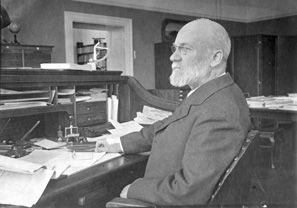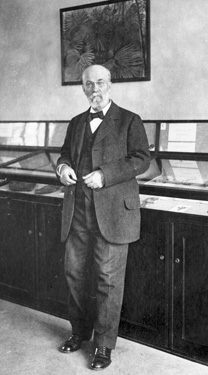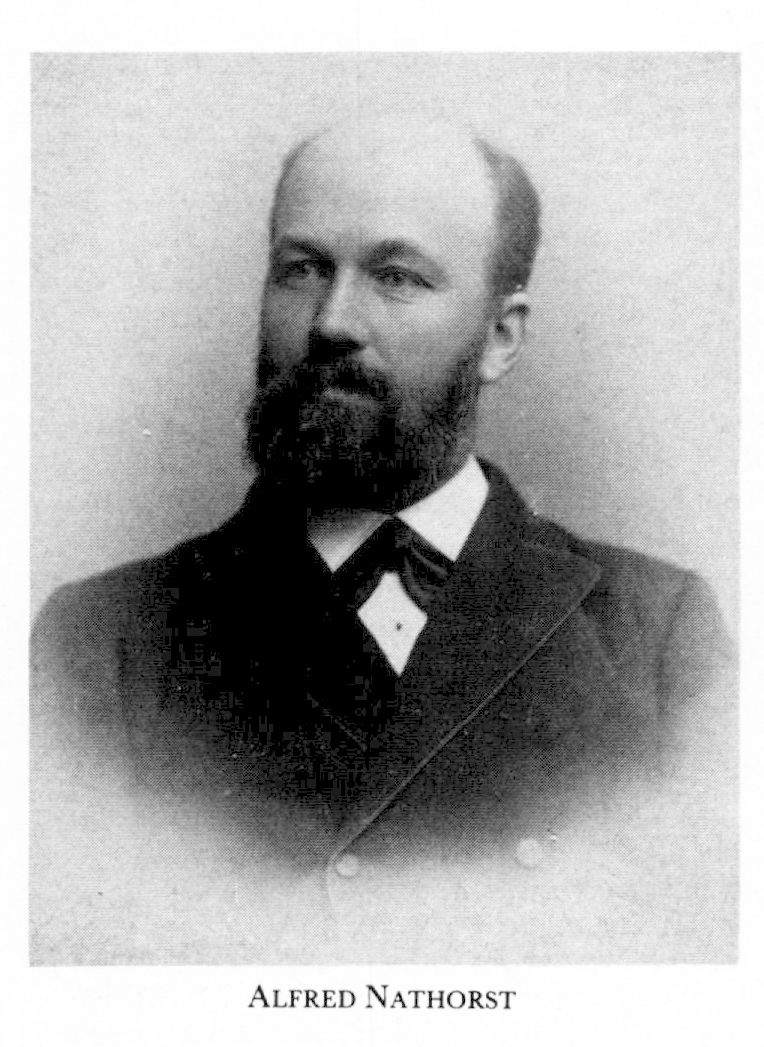Alfred Gabriel Nathorst
Alfred Gabriel Nathorst ( born November 7, 1850 Good Väderbrunn in Nyköping, † January 20, 1921 in Stockholm) was a Swedish botanist, geologist and Arctic explorer. Its official botanical author abbreviation is " Nath "..
Nathorsts interest in science began at a young age, where he devoted himself only botany and later geology. The core of his work lies in the paleobotany.
Geologist
Nathorsts interest in geology were awakened by Charles Lyell's Principles of Geology, work and in 1872 he visited them in England.
Its purely geological work related to the geology of Scania and specifically the deposits of the Cambrian and the coal formation and tectonic changes on the basis of disturbances in the rock strata. In his book Om Nagra förmodade växtfossil (over some suspected plant fossils ) of 1874, he proves that these findings, which were previously described as fossils from older deposits (for example, fossil algae) in reality no real fossils, but the traces of the activity of prehistoric small animals were.
Later, his geological work with the polar regions, the results of which he summarized as a geologist Congress 1910 in Stockholm under the title Contributions to the Geology of Bear Island, Svalbard and König Karl country concerned. He was responsible for the second band of the Swedish textbook Jordens historia ( History of the Earth ), an adaptation of the M. Neumayer Earth's history and the work was partly geological Sveriges ( Sweden geology). According to him, the ammonite genus Nathorstites Böhm, named 1904.
Botanist
Nathorst wrote about the arctic flora, but are more fully his work in paleobotany. Even as a young student, he started in 1870 in late glacial deposits in Scania remains of plants (eg Polar willow, white avens, dwarf birch), which are native to this area no longer, but in the Swedish mountains or in the Arctic occur.
Nathorst described a variety of plant fossils, which he found in the coal deposits of Scania. The rich material gave him the opportunity to comprehensive and systematic morphological studies. He also improved the methods of investigation, such as through the use of collodion to study the structure of the cuticle.
Polar journeys
Nathorst led several expeditions in the direction of northern Arctic Ocean. His first Arctic journey led him in 1870 with the engineer Hjalmar Wilander to Spitsbergen. In 1882 he was back on Svalbard together with the geologist Gerard De Geer. In 1883 he was second after Adolf Erik Nordenskiöld expedition leader at the Greenland expedition with the ship Sofia. 1898 was Nathorst at Bear Island, Svalbard and King Karl Land, 1899 and in Greenland. The latter expedition was to keep an eye out for Andrées missing balloon expedition of 1897, but since nowhere was a sign of life, other parts of the Greenland coast were mapped. The results of the last two trips have been described in Två sommrar i Norra Ishavet ( two summers in the Arctic Ocean ).
Today in Svalbard are the Nathorst country ( between Van lobe fjords and Van Mijenfjorden ), the Nathorstbreen ( N. glacier ) in Van Keulenfjord, named the Nathorstdalen north of Longyearbyen and the Nathorstfjellet ( N. -berg ) southwest of Longyearbyen to Nathorst.
Also found in East Greenland his name in numerous geographical names again. Again, there is a Nathorst country, also the mountains Nathorst Bjerg, Nathorst Fjeld and Nathorst Tinde, the Nathorst Fjord and the Nathorst Glacier.
Museum man
Nathorst in 1884 appointed a Royal Decree professor and until 1917 he was director of the Department of palaeobotanical Naturhistoriska riksmuseet in Stockholm. Because of its good relations with colleagues around the world, he was able to procure the museum a rich comparative material. It put its own findings the foundation in paleobotanical holdings of the institution dar.
Honors
1912 Nathorst was appointed a corresponding member of the Bavarian Academy of Sciences. He also belonged to the Royal Physio Graphic Society in Lund (since 1878), the Royal Swedish Academy of Sciences (since 1885), the Royal Society of Sciences in Uppsala (since 1907) and Kungliga Vetenskaps -och Vitterhetssamhället i Göteborg ( since 1909 ) to. The Universities of Greifswald, Cambridge, Kristiania and St Andrews, distinguished him with honorary doctorates.
Writings (selection )
- To Upper Devonian flora of Bear Island. Kongl. Svenska Vetenskaps - Akademiens handlingar; N.F., 36.3: 60 S., Stockholm 1902
- The Upper Devonian flora of Ellesmere country. In: W. C. Brøgger et al. (Ed.): Report of the Second Norwegian Arctic Expedition in the Fram 1898-1902. Vol 1, Videnskabs -Selskabet, Kristiania, 1904, pp. 1-22
- Contributions to the Geology of Bear Island, Spitsbergen and King Karl country. 1910
- To Devon flora of western Norway. Bergen Museum Arbok; 1914/15, No. 9, 34 p Bergen 1915
- To Paleozoic flora of the Arctic zone: containing d on Spitsbergen, Bear Island on d & on Novaya Zemlya from the swedish expeditions discovered Paleozoic plants. Kungliga Svenska Academy of Engineering, handlingar, Ny följd, 26 (4):. S. 80, Stockholm 1894.









